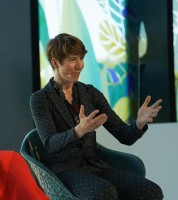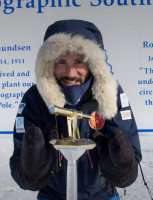New and expanding urban areas concentrate vulnerabilities through their large populations, carbon emission sand assets but they also provide opportunities for action in the face of climate change notably through “climate urbanism”.
Can you introduce us to the concept of climate urbanism and its importance for societal resilience?
Cities have a large role to play in addressing climate change. They concentrate many of the activities that produce carbon emissions, as well as population and assets, thus concentrating vulnerabilities to climate impacts. Yet by virtue of this fact, they also offer many areas of possible intervention and mobilization – including the mobilization of every urban resident in climate action.
Climate urbanism refers to the new ways of thinking about cities fostered by concerns about climate change. Climate change shapes not only the way people imagine the future of cities but also how people design and plan them, which in turn impacts our resilience. Many people fight daily for climate justice, that is, for climate action that redresses existing inequities in our societies. Unfortunately, much of the climate action taking place in cities tends to increase urban inequalities and create further injustice.
Inequality compounds climate impacts. Marginalized people may be greatly exposed to climate risks and simultaneously impacted by them more (e.g., a typhoon may damage a well-built house but destroy a small hut). Marginalized people may also have limited capacity to respond to those risks if they have no access to resources or savings and lack a voice in the political process. This is particularly visible in informal settlements, where people lack access to good quality housing and services, land tenure, or livelihood opportunities and often struggle to make themselves heard in political debates.
How does climate urbanism distinguish between cities? There are many types of urban areas, after all.
The patterns of urbanization are varied and flexible. From forms of suburbanization to fragmented settlements where agricultural land use coexists with industrial ones, the urban landscape is changing rapidly. Some cities are completely new, while others are growing through the agglomeration of villages. Climate change responses will have to consider this spatial diversity. Planning responses such as densification, zoning, or compact cities may have their place, but they are certainly not the only means of intervention. Climate change action must consider the context and history of each urban area and must be developed with or by the people affected. Solutions parachuted from other locations have historically failed.
Building Societal Resilience
This article is part of an AXA Research Fund publication
Read the publicationHow does climate change affect urban resilience?
The most common definition of resilience is the ability to bounce back from shock. A few years ago, some experts advocated redefining resilience as the ability to “bounce forward” – to take actions that create a society that can respond better to the next shock. Responding to the impacts of climate change is not sufficient. Climate action must also address the structural drivers of vulnerability.
One question is how to respond to risks like extreme temperatures, flooding, drought, or food shortages. However, an even more difficult challenge is to respond to the uncertainty generated by the interactions between these phenomena and with the networked infrastructures that support urbanization. For example, in the case of cities dependent on long-distance transfers for their water supply, forest fires in remote areas could directly impact water access.
What about climate change and urban inequality?
Central to climate urbanism is the idea that climate change represents a new moment for cities. What does this mean? It came from observing that actions to address climate change had a different impact on people’s lives in urban environments.
Perhaps the most salient of these is “climate gentrification” and its sibling “green gentrification.” This is where development plans improve an area, reduce its vulnerability to climate change impacts, and raise property prices, forcing poorer populations out.
The Intergovernmental Panel on Climate Change (IPCC) report explains that people living in informal settlements are the urban population most vulnerable to climate change. How do you build resilience in these areas? The IPCC report explains that adaptation may draw on different actions to improve physical, green, and social support infrastructures. In addition, harnessing the efforts of residents in informal settlements – rather than discounting them – is crucial to build resilience. In the Philippines, residents in informal settlements have shown that they can lead incremental housing efforts that build community resilience. In Mozambique, residents regularly organize themselves to provide services such as drainage and waste management that local governments or institutions cannot otherwise provide.
Urban dwellers cannot build resilience alone, however. Building structures that support them is crucial to sustaining these efforts over time. The local government in particular, can play a key role in connecting community efforts with institutions that can sustain them.
What should be the policy responses?
One current project, Community Energy and the Sustainable Transition, or CESET, concerns sustainable community energy in Mozambique, Malawi, and Ethiopia. The energy crisis in Europe has revealed the limits of current models of energy provision. Countries like Malawi and Mozambique are developing regulations to support the development of an alternative model of decentralized energy production. Community energy, where local residents play a role in project management, is a great strategy to build resilience as residents gain control of their resources and energy supply.
A just transition depends on demonstrating how climate innovation works in practice and maximizing innovation locally by creating an atmosphere of experimentation. For example, my team is developing a laboratory in Mozambique to show the potential of community energy. There is a balance to be struck between using expertise that may not be available locally and developing skills at the local level.
There are challenges, such as a lack of recognition of local capacity by sponsors and policymakers and the long-term sustainability of projects. Development aid tends to come through inconsistent, infrequent pots of money that do not necessarily reach communities. But as the pandemic has demonstrated, local governments and communities can effectively mobilize in a rapidly changing situation. There are many possibilities for building climate change resilience, but they need to put communities at the center of the action.
Is there a role for the private sector in climate urbanism?
What could be useful is developing a social enterprise model to provide insurance in informal settlements, for example. Families in these areas, if hit by a flood, for example, can very easily end up with nothing. Providing some security would create resilience. Communities have already led the way by creating savings groups that act as their own forms of insurance. Still, the private sector could help by developing models of insurance dedicated to improving people’s resilience.
Climate change is highly unequal: the most vulnerable are the ones who suffer its effects the most. Cities are not and will not be resilient until every last citizen is resilient. If you have a city where every time there is a heatwave, many people die, which negatively impacts the entire city both morally and practically, that city is not resilient. Climate action should create resilience for everyone. If you improve things for just a minority, you make things worse for the whole.
November 2022



